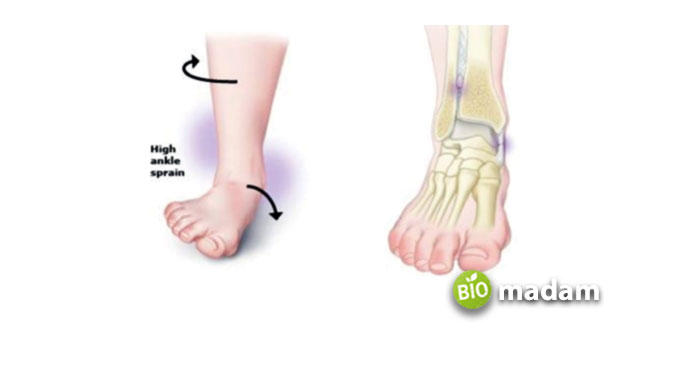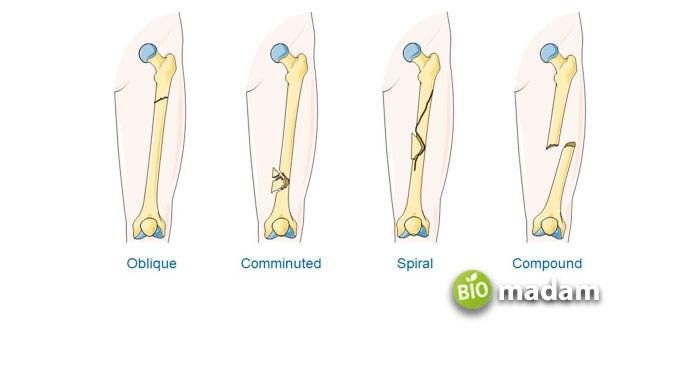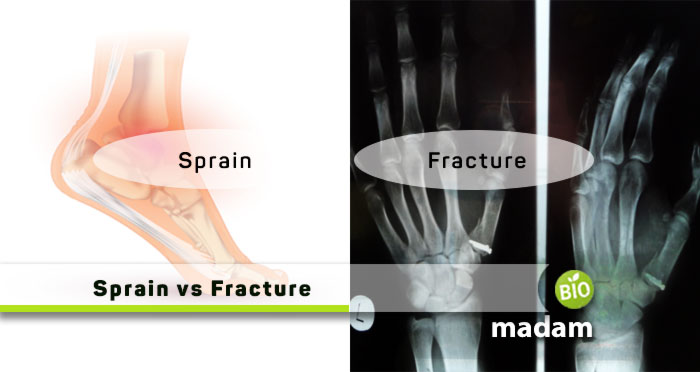Recently updated on October 5th, 2023 at 05:55 am
Accidents and falls can be quite traumatic and may leave you with an injury. Pain in the knees or ankles is one of the most common issues post-accident. This could be due to a fracture, sprain, or strain. While you might be intrigued to check your symptoms with Dr. Google, it might not be of much help. The symptoms of all these injuries are somewhat similar.
The ankle joint is a complex part of the body comprising bones, tendons, and ligaments. The bones and connective tissues work together to create movement. Activity can be pretty difficult if any of these are damaged. You will feel continuous pain while walking or moving around. Sprains and fractures result due to similar reasons, resulting in not-so-distinct symptoms.
Fractures can lead to serious bone and neighboring tissue damage if not treated promptly. The most important difference between fracture and sprain is the nature of the damage. A fracture is a broken bone, while a sprain is a soft tissue injury. Many more differences suggest why you should immediately consult a doctor in case of such pain. Let’s tell you all of them.
Comparison Table
| Characteristics | Sprain | Fracture |
| Definition | Damaged ligament | Broken bone |
| Severity | Less severe | More serious |
| Types | 3 Types | 4 Types |
| Symptoms | Pain, inflammation, bruising, swelling, etc. | Severe pain, crunching sound, restricted movement, etc. |
| Diagnosis | Physical examination | X-ray, MRI |
| Treatment | RICE method | Cast or surgery |
| Healing Duration | Two weeks | Six weeks |
What is a Sprain?
A sprain can be simply defined as a soft tissue injury. It occurs due to stretching or tearing of the ligaments around the joint. Ligaments are stretchy tissues that hold your bone in place. They enable movements by stretching. However, they can extend to a particular extent only. A sprain occurs when the ligaments stretch beyond the limit. This can lead to damage and cause an ankle sprain.
Types of Sprain
Sprains are categorized into three types
Inversion Sprain
An inversion sprains result from twisting or turning in your ankle. The pain radiates to the outside of the ankle.
Eversion Sprain
As opposed to an inversion sprain, the eversion sprain occurs from twisting your ankle out. The pain is on the interior side.
High Ankle Sprain
A high ankle sprain comes from a wrong jump on a surface that pushes the ankle upwards.

Symptoms of Sprain
Though the symptoms of sprains and fractures are similar, you can identify sprains through:
- Movement restriction in the injured area
- Pain
- Swelling
- Sensation around the joint
Diagnosis of Sprain
The diagnosis of a sprain, strain and fracture is interlinked. When you visit a doctor complaining of pain and swelling in a joint or bone, they perform a physical examination. The doctor will ask you to move your ankle in different ways to understand if the ligament is damaged.
Treatment of Sprain
Sprains typically do not require extensive treatment like fractures. The most important factor while treating a sprain is taking enough rest. Moving with a damaged ligament can cause a worsening of the condition. Taking anti-inflammatory drugs like Naproxen or Ibuprofen can help relieve swelling. Serious sprains may require surgery as the ultimate treatment option.
- Doctors suggest trying the RICE regimen until your ligament heals.
- Rest as much as you can
- Ice the ankle to relieve inflammation
- Compression on the site of injury with an elastic bandage
- Elevation of the ankle above the heart
What is a Fracture?
A fracture in any part of your body is a broken bone due to an accident, fall, or sports injury. The ankle comprises three bones; the tibia, fibula, and talus. These bones of the skeletal system provide structural strength to the ankle while the tendons and ligaments contribute to the movement. If one of the bones is broken, you might not feel it and continue moving. But an injury in multiple bones can lead to unstable walking, and you will need immediate medical assistance. Sometimes a fracture may also cause ligament damage if not treated in time.
Types of Fracture
The four types of fractures are as follows:
Hairline Fracture
A hairline fracture is also known as a stress fracture. It occurs as a small break or a crack in the bone.
Compression Fracture
The bone does not break in a compression fracture. Instead, it becomes flatter because of compression.
Oblique Fracture
A diagonal break in the bone is termed an oblique fracture.
Comminuted Fracture
When a bone breaks into several pieces, it is called a comminuted fracture.

Symptom of Fracture
Having a fracture has the same symptoms as a sprain with a few others like
- Swelling
- Limb deformity
- Inability to move
- Unable to put weight on the ankle
- An audible cracking sound from the ankle on movement
Diagnosis of Fracture
Typically the doctor will first rule out if it is a sprain. If the physical examination does not indicate a ligament injury, you will need an x-ray. The x-ray acts as the primary diagnostic test for a fracture, followed by an MRI or CT scan where needed.
Treatment of Fracture
A broken bone takes more time to heal than a damaged tendon. Typically when you visit a doctor with a fracture, they give you a cast to keep the bone in its place. The cast takes four to six weeks to heal the bone and fix it. Avoid workout immediately after the removal of the cast. Sometimes, the bone damage may need an invasive treatment such as surgery for relief. Surgical treatments for fractures include
- Percutaneous fixation by using rods or pins keeps your bone in place.
- External fixation requires the use of wires and pins inserted into the bone. They are joined together by an external scaffold.
- Skeletal traction uses pins, weights, and pulleys to heal bones of the lower body.
Similarities Between Sprain and Fracture
- Sprains and fractures are common in joints such as the ankle and wrists.
- They show similar signs and symptoms like swelling and pain.
- You may experience bruising around the affected area in sprains and fractures.
Differences Between Sprain and Fracture
Definition
Sprain
A sprain refers to damage to the ligament resulting in pain.
Fracture
Whereas a fracture is defined as a broken bone that may restrict activity.
Severity
Sprain
Sprains do not require as extensive treatment as fractures. Yet, they must be treated in time.
Fracture
On the contrary, fractures are more severe than sprains and need immediate intervention.
Types
Sprain
Strains are of three types; inversion, eversion, and high ankle sprain.
Fracture
The four types of fractures are hairline, compression, oblique, and comminuted.
Symptoms
Sprain
Symptoms of a sprain include pain, swelling, bruising, sensation, or popping sound near the damaged area.
Fracture
Besides bruising and pain, other fracture symptoms are limb deformity, inability to put weight on the joint, audible crunching sound, etc.
Diagnosis
Sprain
Physicians usually diagnose sprains through a physical examination.
Fracture
At the same time, fractures require an x-ray to locate the broken bone. Further analysis may require an MRI or CT scan per need.
Treatment
Sprain
You can treat a sprain with the RICE (rest, ice, compress, elevation) method. Anti-inflammatory drugs help with relieving inflammation in the joint.
Fracture
However, fractures usually require a cast to fix the bone in place. Some fractures may require invasive treatments like percutaneous fixation, external fixation, or traction.
Duration of Healing
Sprain
Sprains take around two weeks to heal. However, you must not exercise or run intensively for eight weeks.
Fracture
As opposed to sprains, fracture casts take 4 to 12 weeks to heal the bones. Doctors advise not to involve in strenuous activities immediately.
How are a Fracture and a Broken Bone Different?
Fracture and break are used interchangeably, and there is no difference between the two. A break is a common term, while a fracture is more professional. Doctors usually refer to a broken bone as a fracture instead of a break.
The Bottom Line
Sprains and fractures typically occur due to falling, accidents, or sports injuries. The symptoms are quite similar, yet the main difference is the inability to put weight on a fractured bone. You might not feel the same pain or pressure in a sprain. Sprains are characterized by pain and swelling, whereas fractures restrict movement. It takes around two weeks for a sprain to heal with rest and compression. Contrarily, fractures require a six-week cast or invasive surgery in case of serious damage to the bone.

Hello, I would like to introduce myself to you! I am Chelsea Rogers, an experienced blog writer for science articles, holding an MPhil degree. My enthusiasm to grab the best knowledge, let it relate to botany, zoology, or any other science branch. Read my articles & let me wait for your words s in the comment section.

